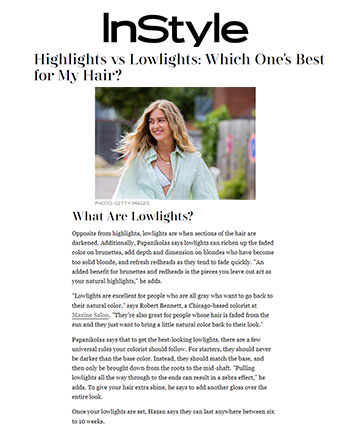InStyle July 27, 2022
 InStyle
InStyle
Hair
Highlights vs Lowlights: Which One's Best for My Hair?
Decisions, decisions...
We could all wax poetic about how much we love playing up our hair. And whether yours is short or long, thin or coarse, virgin or dyed hair, the possibilities are endless.
So for those looking to spruce up their hair by adding color, getting highlights or lowlights can do the trick. In one appointment, your hair can have more visible dimension, and the treatment could very well change your entire look
But before we get in too deep, let's pause for a sec to make sure we cover the basics.
Here, we tapped three celebrity hairstylists to answer all your questions about the difference between highlights and lowlights, and how to figure out which color treatment is right for you.
What Are Highlights?
As celebrity colorist Rita Hazan puts it, highlights do exactly what they sound like — they "highlight" your base color. "If you want to lighten up your color, you should highlight," she says.
While highlights can be placed anywhere you want, celebrity colorist and Matrix brand ambassador, George Papanikolas says the most flattering ones should act as an accent to your existing color. "They can be used as an all-over major color change, but then the upkeep is much higher," he explains. They're typically placed near the face to brighten the client's face — think money pieces.
The most natural-looking and flattering highlights are when they are within four shades of your natural color, according to Papanikolas. "Any lighter and they can look harsh." he warns. However, there is an exception. For people with naturally very dark hair, he says it's best to lift the base color first one to two shades and then highlight to bridge the gap and get a softer blended end result.
When at the salon, your colorist will likely highlight your hair in one of two ways: foils or balayage. Balayage refers to free-hand painting, and foils require exactly that to hold the hair being lightened from the rest of the hair.
Once your highlights are done, Hazan says you can expect them to last anywhere between eight to 12 weeks. "But there are many factors," she says. "It depends on how many highlights someone has, how fast their hair grows, and how well they maintain their hair. Some women highlight as early as every six weeks."
What Are Lowlights?
Opposite from highlights, lowlights are when sections of the hair are darkened. Additionally, Papanikolas says lowlights can richen up the faded color on brunettes, add depth and dimension on blondes who have become too solid blonde, and refresh redheads as they tend to fade quickly. "An added benefit for brunettes and redheads is the pieces you leave out act as your natural highlights," he adds.
"Lowlights are excellent for people who are all gray who want to go back to their natural color," says Robert Bennett, a Chicago-based colorist at Maxine Salon. "They're also great for people whose hair is faded from the sun and they just want to bring a little natural color back to their look."
Papanikolas says that to get the best-looking lowlights, there are a few universal rules your colorist should follow. For starters, they should never be darker than the base color. Instead, they should match the base, and then only be brought down from the roots to the mid-shaft. "Pulling lowlights all the way through to the ends can result in a zebra effect," he adds. To give your hair extra shine, he says to add another gloss over the entire look.
Once your lowlights are set, Hazan says they can last anywhere between six to 10 weeks.
What's the Best Way to Pick Between Highlights and Lowlights?
"It's pretty simple. If you want to darken up your color a little, you use lowlights. If you want to lighten up your color, you use highlights," says Hazan.
However, Papanikolas adds that highlights usually require bleach lightener to get the ideal tones and, as such, they can be harsher on the hair than a lowlight. So if you have existing damage, such as chemical treatments, heat damage, or previous color, consider how much upkeep you're willing to do to keep your hair healthy before taking the plunge.
